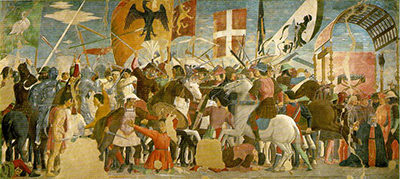Originally painted on the east wall of the Church of San Francisco at Arezzo, this fresco was commissioned by the Bacci family in the fifteenth century as part of a large-scale project that included different pieces throughout the church.
However, Piero della Francesca was not the first artist chosen as the commission was originally secured by Bicci di Lorenzo who unfortunately died in 1452. Consequently, Francesca was asked to undertake the work in the choir area after the original artist had completed a number of paintings elsewhere in the church. The theme for Francesca's frescos for the choir area was to cover the story of the True Cross which gave him a degree of freedom as the story was so well known.
The Battle Between Heraclius and Chosroes was created to reflect the contemporary conflict between the Turks and the Byzantine Empire. It depicts the story of how the Christian Emperor Heraclius attacked the troops of King Chosroes after he had stolen the true cross and had it installed as part of his throne, embedded on his right side as a sacrilegious parody of Christ. Critics have suggested that the glamorous image of victory in war is part of a propaganda appeal to encourage young Christians to join the Crusades against the infidels. Indeed, the prominence of the Christian flag and the use of colour to give the Christian fighters a sense of power and glory certainly reinforces this notion.
The centre of the image accentuates the fervent dramatic action of the battle, although many of the characters appear to be static. Almost all Christian characters are placed in positions of power and are depicted using colours that suggest heavenly light: a knight brandishes a shining silver sword; a crystal white charger tramples an infidel underfoot; a warrior in silver sleeves holds a dagger over a heathen's throat. Good and evil is reflected in the contrast between the bright and light colours of the Christian army and the darker, earthier shades of the submissive Turks. The sky reflects the light colours of the army as though heaven smiles on the army's success while the Christian flag flies high at the top of the triangular shape formed by the characters in the melee of intense battle. To the right of the action, King Chosroes has sunk to his knees in beaten submission, ready to face the consequences of his actions.




